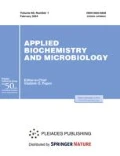Abstract
The consumption of phenanthrene in soil by model plant–microbial associations including natural and transconjugant plasmid-bearing rhizospheric strains of Pseudomonas fluorescens and P. aureofaciens degrading polycyclic aromatic hydrocarbons was studied. It was shown that phytoremediation of soil polluted with phenanthrene in the rhizosphere of barley (Hordeum sativum L.) was inefficient in the absence of the degrading strains. Inoculation of barley seeds with both natural and transconjugant plasmid-bearing Pseudomonas strains able to degrade polycyclic aromatic hydrocarbons (PAH) protected plants from the phytotoxic action of phenanthrene and favored its degradation in soil. Rape (Brassica napus L.) was shown to be an appropriate sentinel plant, sensitive to phenanthrene, which can be used for testing the efficiency of phenanthrene degradation in soil. Biological testing with the use of sensitive rape plants can be applied for estimation of the efficiency of phyto/bioremediation of PAH-polluted soils.
Similar content being viewed by others
REFERENCES
Juhasz, A.L. and Naidu, R., Int. Biodeterioration Bio-degradation, 2000, vol.45, no. 1, pp. 57-88.
Dietz, A.C. and Schnoor, J.L., Environ. Health Perspect, 2001, vol. 109, no. 1, pp. 163-168.
Newman, L.A., Strand, S.E., Choe, N., Duffy, J., and Ekuan, G., Environ. Sci. Technol., 1997, vol. 31, pp. 1062-1067.
Salt, D.E., Smith, R.D., and Raskin, I., Annu. Rev. Plant Physiol. Plant. Mol. Biol, 1998, vol. 49, pp. 643-668.
Lynch, J.M. and Whipps, J.M., Plant Soil., 1990, vol. 129, no. 1, pp. 1-10.
Bloemberg, G.V. and Lugtenberg, B.J., Curr. Opin. Plant Biol., 2001, vol. 4, no. 4, pp. 343-350.
Weisburg, W.G., Barns, S.M., Pelletier, D.A., and Lane, D.J., J. Bacteriol., 1991, vol. 173, no. 2, pp. 697-703.
Kochetkov, V.V., Balakshina, V.V., Mordukhova, E.A., and Boronin, A.M., Mikrobiologiya, 1997, vol. 66, no. 2, pp. 211-216.
Sambrook, J., Fritsch, E.F., and Maniatis, T., Molecular Cloning: A Laboratory Manual, Cold Spring Harbor, New York: Cold Spring Harbor Lab., 1989.
Mordukhova, E.A., Kochetkov, V.V., Lobanova, E.V., Slepen'kin, A.V., and Boronin, A.M., Mikrobiologiya, 2000, vol. 69, no. 6, pp. 844-849.
Braginskii, L.P., Gidrobiol. Zh., 2000, vol. 36, no. 5, pp. 50-70.
Dyatlov, S.E. and Petrosyan, A.G., Algologiya, 2001, vol. 11, no. 1, pp. 145-154.
Evgen'ev, M.I., Sorosovskii Obrazovatel'nyi Zhurnal, 1999, vol. 48, no. 11, pp. 29-34.
Dzombac, D.A. and Luthy, R.G., Soil Sci., 1984, vol. 137, pp. 292-308.
Aprill, W. and Sims, R.C., Chemosphere, 1990, vol. 20, pp. 253-256.
Jacobsen, C.S., Plant Soil, 1997, vol. 189, pp. 139-144.
Park, K.S., Sims, R.C., Dupont, R.R., Doucette, W.J., and Matthews, J.E., Environ. Toxicol. Chem., 1990, vol. 9, pp. 187-195.
Author information
Authors and Affiliations
Rights and permissions
About this article
Cite this article
Anokhina, T.O., Kochetkov, V.V., Zelenkova, N.F. et al. Biodegradation of Phenanthrene by Pseudomonas Bacteria Bearing Rhizospheric Plasmids in Model Plant–Microbial Associations. Applied Biochemistry and Microbiology 40, 568–572 (2004). https://doi.org/10.1023/B:ABIM.0000046992.01220.35
Issue Date:
DOI: https://doi.org/10.1023/B:ABIM.0000046992.01220.35




